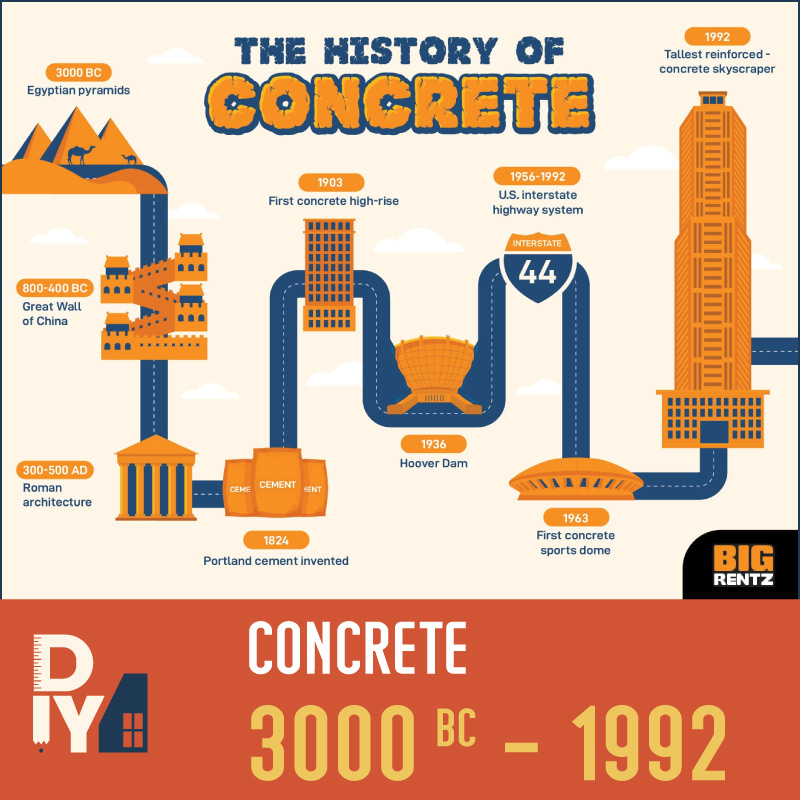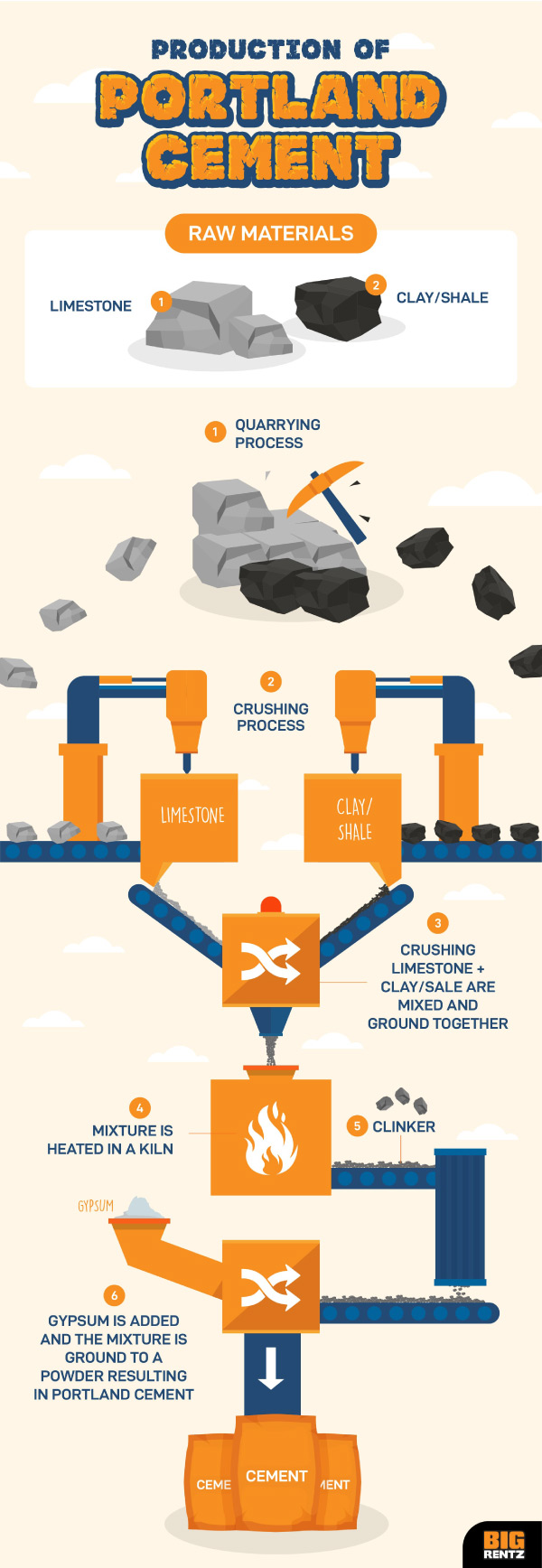History of concrete | Among the ancient Assyrians and Babylonians, the bonding substance most often used was clay. The Egyptians developed a substance more closely resembling modern concrete by using lime and gypsum as binders. Lime (calcium oxide), derived from limestone, chalk, or (where available) oyster shells, continued to be the primary pozzolanic, or cement-forming, agent until the early 1800s. In 1824 an English inventor, Joseph Aspdin, burned and ground together a mixture of limestone and clay. This mixture, called portland cement, has remained the dominant cementing agent used in concrete production.
Contents:

1. What is concrete?
According to Wikipedia, Concrete is a composite material composed of fine and coarse aggregate bonded together with a fluid cement (cement paste) that hardens (cures) over time. In the past, lime based cement binders, such as lime putty, were often used but sometimes with other hydraulic cements, such as a calcium aluminate cement or with Portland cement to form Portland cement concrete (named for its visual resemblance to Portland stone). Many other non-cementitious types of concrete exist with other methods of binding aggregate together, including asphalt concrete with a bitumen binder, which is frequently used for road surfaces, and polymer concretes that use polymers as a binder. Concrete is distinct from mortar. Whereas concrete is itself a building material, mortar is a bonding agent that typically holds bricks, tiles and other masonry units together.
2. Concrete History Through the Ages – History of Concrete
So how did we arrive at the current state of concrete? Through a process of evolution, like so many other means of construction and development. First, ancient people made discoveries about naturally occurring materials they could use it to improve fundamental parts of their infrastructure — homes, fences, wells, etc. The generations who followed them built upon that knowledge, making improvements here and there until the industrial age descended and sped up building developments to their current level.
Origins and Precursors
12 million years ago – Naturally occurring cement
On land that is now Israel, spontaneous combustion produced reactions between limestone and oil shale, resulting in natural deposits of “naturally occurring cement” that would make possible the future formation of concrete.
10,000 BC – Earliest limestone structure
Limestone — also often called “lime” — plays the earliest role in the story of concrete, as the base ingredient in cement, and it’s been used for millennia. Predating another massive stone temple, Stonehenge, by 6,000 years, the Göbekli Tepe in modern-day Turkey was the earliest known limestone structure. Limestone made up the T-shaped pillars of this temple, which were built and carved by prehistoric people who had not yet developed metal tools or even pottery.
6500 BC – Desert cisterns
The first concrete-like structures, secret underground cisterns for storing scarce water, were built by Nabataea or Bedouin traders who developed a small empire in the desert oases of southern Syria and northern Jordan. Some of these cisterns still exist in those areas today.
5600 BC – Pre-concrete floors
In the former country of Yugoslavia, in the area of Lepenski Vir along the Danube River, huts were found in the mid-1960s with a semblance of concrete floors. The lime cement that was used probably came from a deposit upriver and was mixed with sand, gravel, and water to resemble concrete mixtures of our time.
Monuments of Antiquity
3000 BC – Egyptian Pyramids
Limestone rocks or concrete blocks? Despite some hotly debated speculation about blocks in the Egyptian pyramids being formed with an early type of concrete more than 5,000 years ago, it’s more widely believed across the field of archaeology that the limestone blocks were hauled from quarries nearby. To make the mortar for holding the blocks together, the builders mixed straw with mud that contained crushed limestone, gypsum, and clay.
1400-1700 BC – Minoan structures on Crete
The Minoan society on the island of Crete, forerunners to the Greeks and credited as the first European civilization, used a building material that mixed clay and a type of volcanic ash called pozzolana for building for floors, foundations, and sewers.
1300 BC – First “lime” coating
Middle Eastern builders burned limestone and mixed it with water, then used the mixture to coat the outsides of their pounded-clay walls. When the mixture reacted with the air, it formed a hard, protective surface — and laid the foundations, so to speak, for modern versions of cement.
1000 BC – Grecian tombs
The Mycenaeans used their early form of cement to build tombs. You can see some of them today in the Peloponnese in Greece.
770-476 BC – China’s Great Wall
The northern Chinese used a form of cement for building boats and their section of the Great Wall. Over the centuries of the wall’s construction, materials used for its entire span included reeds, willow branches, wood, compacted sand, mud, and 100 million tons of stone and brick. Where these weren’t cemented by limestone mortar, they were held together by a mortar made of glutinous, sticky rice.
700 BC – Kilns, mortar, and hydraulic lime
The same Bedouins who pioneered underground cisterns later built kilns to produce a rudimentary kind of hydraulic lime — cement that hardens underwater — for waterproof mortar that advanced the construction of houses, floors, and newly waterproof cisterns underground.
From Roman Empire to Renaissance | History of Concrete
300-500 AD – Roman architecture
The Romans started with the same raw materials as the Minoans — volcanic ash found near Pompeii and Mount Vesuvius, which they used to thicken a mixture of kilned limestone, ground-up rocks, sand, and water — allowing them to build ramps, terraces, and the roads that eventually connected the whole empire. Pouring the mixture into molds soon allowed builders to create vaults and domes, as well as the arches of the empire’s iconic aqueducts and bathhouses. Roman concrete has endured earthquakes, lightning strikes, crashing sea waves, and thousands of years of weathering.
82 AD – The Colosseum
After Rome’s civil war, the emperor known as Vespasian set out to build the largest theater in the world, with more than 50,000 seats. Today we know the world’s first stadium, completed 1,937 years ago, as “The Colosseum.” About a third of the structure still stands nearly two millennia later, an iconic symbol of the Roman Empire.
117-125 AD – The Pantheon — and the loss of concrete
Rome’s Pantheon, soon to celebrate its 1,900th birthday, is as sturdy as ever. The temple’s unreinforced concrete dome was twice as wide and high as any dome ever created at the time, spanning 143 feet with its famed “oculus” in the center. Its mammoth weight is buttressed by incredibly thick concrete walls and eight barrel vaults, all reinforced with brick — but no internal support.
Today’s engineers wouldn’t dare build an unreinforced dome of that size, and they may never know the secret to the Pantheon’s enduring stability. We do know that Emperor Hadrian’s engineers adjusted the concrete recipes, using more volcanic ash than rock to make the dome lighter, and more rock aggregate in the walls for heavier reinforcement. But when the Roman Empire fell in 476 AD, the unprecedented Roman recipe for concrete was lost to the world.
1507 – The Renaissance – Pont Notre-Dame Bridge
Just after the Dark Ages, an Italian friar named Giovanni Giocondo built the Pont Notre-Dame Bridge in Paris using remnant information from the ancient Roman cement recipe. About 250 years afterward, the structure was demolished because houses built atop the bridge added too much weight. Giocondo would go down in history as the only person to attempt building with concrete during the Renaissance.
Advancements in Concrete
16th-century improvements
A bricklayer in Andernach, Germany, tried mixing volcanic ash called trass with lime mortar. The resulting material was water-resistant and strong — and the chain reaction started by the discovery would lead to the creation of modern cement.
17th-century concrete trade
In the 17th century, the Dutch (who were already adept at building in water) sold trass to France and Britain for use on buildings that required waterproof properties. The two rival countries immediately began competing to create their own hydraulic building materials.
1793 – Modern production of hydraulic lime for cement
When British civil engineer John Smeaton was commissioned to build a new lighthouse on the Eddystone Rocks in Cornwall, England, he set about searching for the most durable and waterproof building material he could find. After finding limestone nearby with a high concentration of clay, he fired it in a kiln and turned it into clinker. He ground it into powder and mixed it with water to create a paste, with which he built the lighthouse.
In the process — and more than 1,000 years after the secrets of concrete were lost — Smeaton rediscovered how to make cement. Before long, manufacturers started marketing his discovery as “Roman cement.” And the Eddystone Lighthouse stood for nearly 130 years, outlasting the rocks that eroded out from under it.
1824 – Invention of Portland Cement
Englishman Joseph Aspdin refined the process by carefully proportioning limestone chalk with clay and burning the mixture in a kiln until the carbon dioxide was removed. He also heated alumina and silica until the materials became glass-like, then pulverized them and added them into the limestone mixture along with gypsum.
The resulting chemical combination of calcium, silicon, aluminum, iron, gypsum, and other mineral ingredients makes up the distinct formula for Portland cement, the basic ingredient of concrete. Aspdin named the result “Portland” cement because it resembled the high-quality building stones quarried in nearby Portland, England.
1836 – Strength testing
The first testing of concrete’s tensile and compressive strength took place in Germany. Tensile strength is the ability to resist tension or pulling apart; compressive strength is the ability to resist compression, or pushing together.
1850s – Reinforcement with steel mesh patented
A French gardener, Joseph Monier, experimented successfully with pouring concrete over a steel mesh. (Concrete and steel expand at a similar rate when they heat up, making them a perfect pairing). Monier patented several variants of his invention for use with railway sleeper cars, building slabs, and pipes. Reinforced concrete is much stronger and more practical than the unreinforced stuff. It can span larger gaps, allowing concrete to soar in the form of bridges and skyscrapers.
1880s – Reinforcement with iron bars
California engineer Ernest Ransome began testing concrete and 2-inch iron rods to see if the materials would bond. When they did, Ransome went a step further by twisting the iron bars to create an armature around which he could “build” concrete into any desired shape — an experiment which also worked. Today we call this system reinforcing bar, or rebar, although modern engineers typically use steel instead of iron.
Ransome’s system soon would be used in commercial buildings, roads, bridges, and even the first skyscrapers. Famed architect Frank Lloyd Wright began to implement rebar concrete technology in modern architecture. Some of Wright’s most famous buildings — including Unity Temple in Oak Park, Illinois, considered the world’s first modern building; and Fallingwater in Mill Run, Pennsylvania, his most celebrated work — were made of reinforced concrete.
1880s – Prestressing steel patented
The process of prestressing steel was patented to make concrete stronger and allow engineers to use less steel and concrete.

3. Modern Concrete Structures
Ever since Ransome developed the use of rebar, concrete has built all types of monumental buildings and infrastructure works. The Panama Canal, World War II bunkers, and the famed Sydney Opera House share a building material with some of the toughest — and most visionary — buildings in the world.
1889 – First reinforced concrete bridge – Alvord Lake Bridge, San Francisco
Alvord Lake Bridge was built in 1889 in San Francisco, CA. The first reinforced concrete bridge, it survived the 1906 San Francisco earthquake and others with no damage. It still exists today, more than 100 years after it was built.
1891 – First concrete street in America – Bellefontaine, Ohio
In 1891, a man named George Bartholomew built the first concrete street in America in Bellefontaine, Ohio. Today, pervious concrete is being advocated as the best, and most environmentally friendly, surface for streets.
1903 – First concrete high-rise – The Ingalls Building, Cincinnati
In Cincinnati in 1903, Ransome’s system made possible the first concrete high-rise, the 16-story Ingalls Building. That neck-breaking height made the skyscraper one of the great engineering feats of its time.
1899 – Vienne River Bridge
The Vienne River Bridge in Chatellerault, France, built in 1899, is one of the most famous reinforced concrete bridges in the world.
1908 – Concrete homes – Union, New Jersey – designed and built by Thomas Edison
The nation’s first concrete homes were designed and built in Union, New Jersey, by none other than Thomas Edison. These homes still exist today.
1913 – First Ready-Mix delivery – Baltimore
The first load of “ready-mix” was delivered in Baltimore. Having concrete mixed in one place (a central plant) and then delivered by truck for use at a job site was a revolution for the concrete industry.
1915 – Colored concrete – L.M. Scofield, the first company to produce color for concrete
Lynn Mason Scofield founded L.M. Scofield, the first company to produce color for concrete. Their products included color hardeners, color wax, integral color, sealers, and chemical stains.
1930 – Air-entraining agents – resistance to damage from freezing and thawing
In 1930, air-entraining agents were used for the first time in concrete to resist damage from freezing and thawing — a decided boon to cold-weather building practices across the United States and the world.
1936 – Hoover Dam – largest-scale concrete project ever completed at the time
The Hoover Dam is located on the border of Arizona and Nevada. Completed in 1936 to hold back the mighty Colorado River, the dam is made of 3.25 million cubic yards of concrete, with an additional 1.11 million used for its power plant and surrounding structures.
1956-1992 – The American interstate highway system
All of America’s roads in the interstate highway system are made of reinforced concrete.
1963 – Assembly Hall @ University of Illinois – first concrete sports dome
The first sports arena with a concrete dome was built on the campus of the University of Illinois at Urbana-Champaign in 1963. Known as Assembly Hall, the arena looks like a flying saucer and seats more than 16,000 in a perfect concrete circle.
1970’s – Fiber reinforcement – method to strengthen concrete
Fiber reinforcement, in which glass, carbon, steel, nylon, or other synthetic fibers are mixed into wet concrete before pouring, was introduced as a way to strengthen concrete. Fiber reinforcement can be used to strengthen buildings as well as outdoor features from driveways, slabs, and sidewalks to swimming pools, patios, and decks.
1992 – Tallest reinforced concrete building – Chicago
At 65 stories, the skyscraper at 311 South Wacker Drive in Chicago was the world’s tallest reinforced concrete building at the time it was built. The postmodern structure is known only by its street address.
References
- The Roman Pantheon: The Triumph of Concrete Archived 6 October 2014 at the Wayback Machine. Romanconcrete.com. Retrieved 19 February 2013.
- National Highway Institute. “Portland Cement Concrete Materials“
- “What is the development impact of concrete?“. Cement Trust. 24 October 2010. Archived from the original on 17 September 2012. Retrieved 10 January 201
- The Cement Sustainability Initiative: Our agenda for action, World Business Council for Sustainable Development, page 20, published 1 June 2002.
- “The History of Concrete“. Dept. of Materials Science and Engineering, University of Illinois, Urbana-Champaign. Archived from the original on 27 November 2012. Retrieved 8 January 2013.



